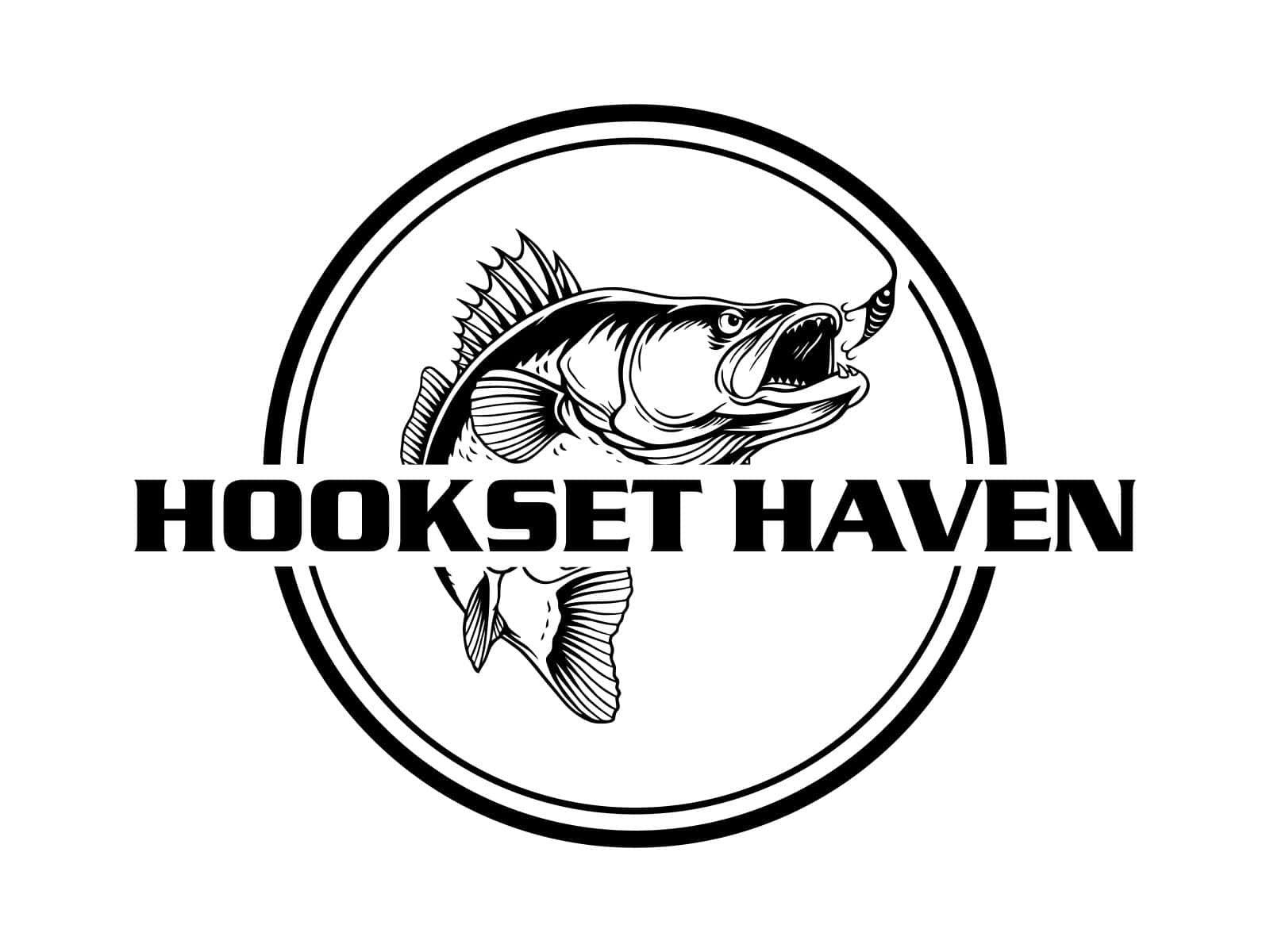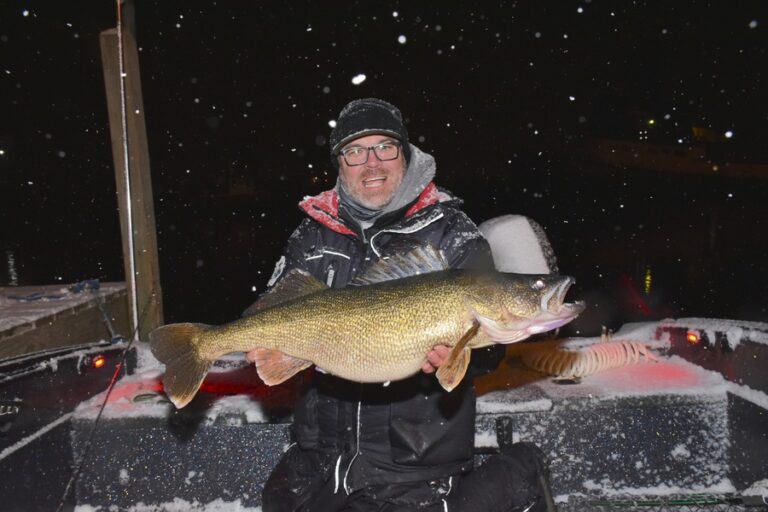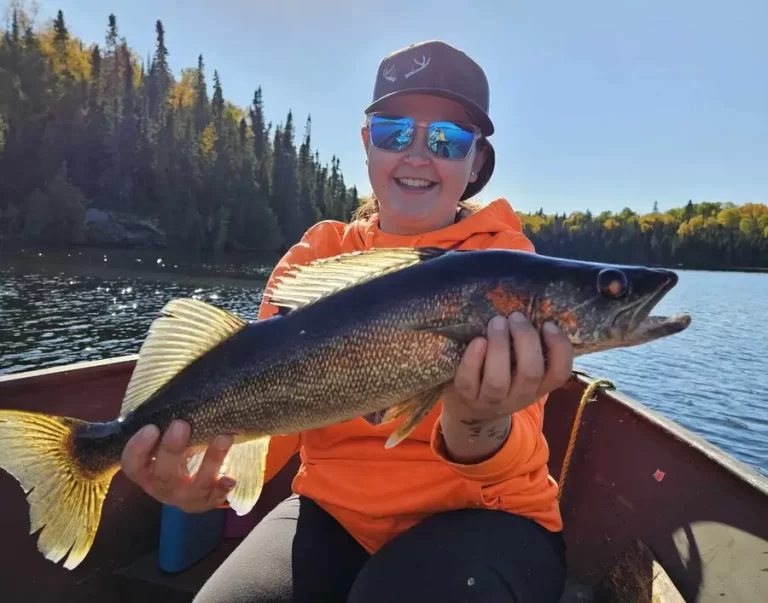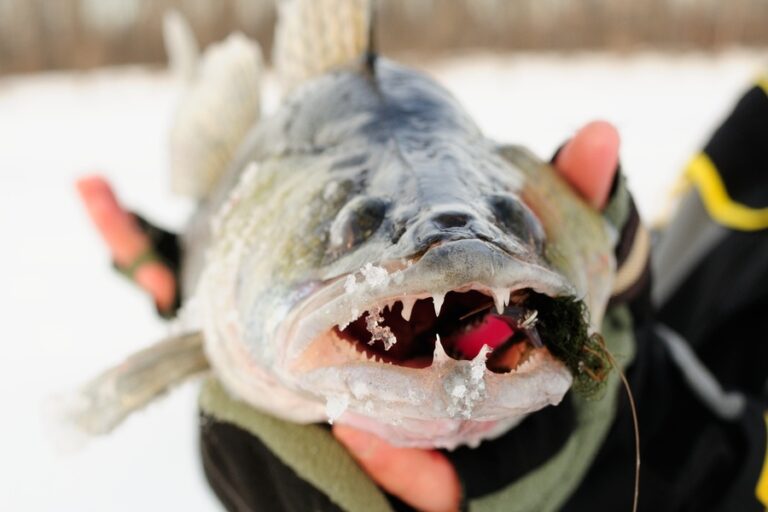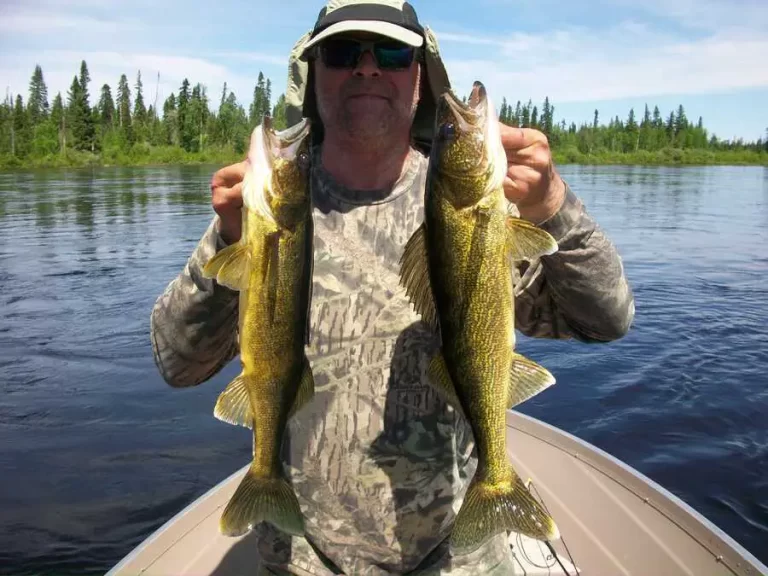Walleye Fishing in Colorado (Best Lakes & Rivers)
Walleye fishing in Colorado can be very good at prime locations like Cherry Creek Reservoir and Lake Pueblo. The best times to fish walleye are fall and early spring.
I worked two seasonal fisheries jobs in the state of Colorado and have fished in the state for walleye more than 20 times. I also have resident contacts who fish some of the reservoirs highlighted in this article as their home waters. I owe much of the expertise in this article to their insights.
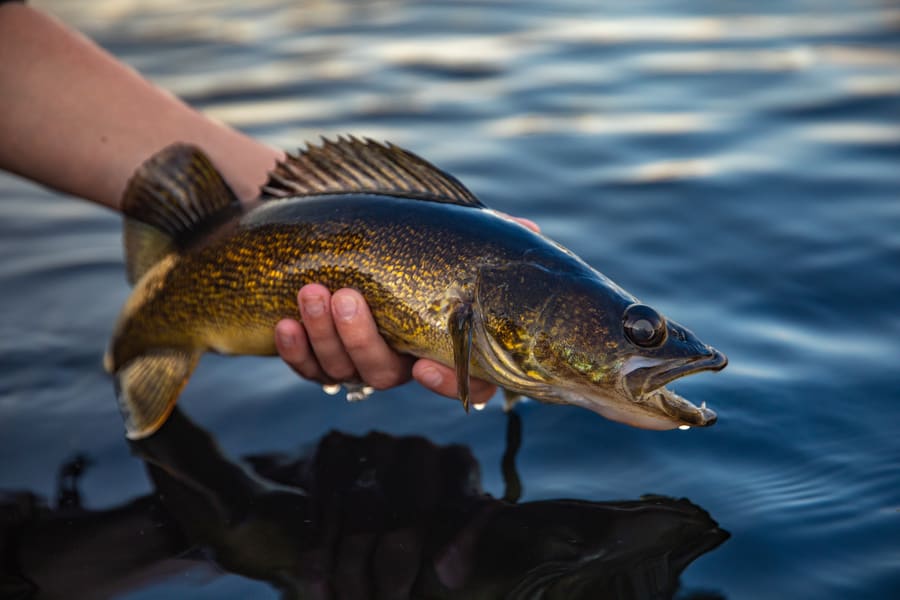
Table of Contents
Walleye Fishing in Colorado
Colorado offers great opportunities for walleye fishing, particularly in its major lakes and reservoirs such as Cherry Creek Reservoir, Lake Pueblo, and Boyd Lake. While Colorado might not be as famous as some northern states for walleye fishing, its diverse and often clear water bodies present abundant opportunities for anglers.
In Colorado, walleye tend to inhabit deeper areas of lakes during the warmer months. This behavior is somewhat different from their northern counterparts, likely due to the state’s relatively clearer and warmer waters. In Colorado, structures like drop-offs, main lake points, and underwater humps are particularly attractive to walleye. These features in Colorado’s lakes create ideal environments for walleye, especially during the summer when they seek deeper, cooler waters.
You’ll notice the clearer water in Colorado means walleye will be a lot more skittish. I strongly recommend using fluorocarbon line. My favorite walleye line for Colorado is Seaguar Red Label.
You may also be interested in Utah walleye fishing information.
Understanding Walleye in Colorado
In Colorado, walleye are commonly found in clear waters with plenty of covers, such as underwater structures, rocky areas, and weed beds. They favor spots where the bottom shifts from sand to gravel or where deep and shallow waters meet sharply.
Seasonally, walleye habits vary. Springtime sees them in shallow waters for spawning, which is a great time for fishing. During the hot summer months, they move to cooler, deeper waters, and as fall approaches and temperatures drop, they come back to the shallows. In winter, they prefer deeper areas again, staying there based on the cold and food availability.
My buddy fishes in Western Colorado and he likes fall walleye fishing along the deep edge of weeds and long tapering points. He says it works great on all the major walleye reservoirs out there.
Best Locations for Walleye Fishing in Colorado
Cherry Creek Reservoir
This beautiful reservoir offers clear water with varying depths and sharp drop-offs. Make sure you use fluorocarbon as walleye are typically finnicky. It offers great walleye fishing with potential for trophy-class fish. The lake does get a ton of fishing and boating pressure in summer and on nice weekends. I recommend fishing in early spring or early September as you’ll have the best fishing action with less competition from anglers. Shoreline walleye fishing can be decent in spring and fall where deeper structure and drop-offs are close to shore.
Boyd Lake
Boyd Lake is a good walleye fishing because of its clear, deep water and varying depths. The clear water will make walleye more cautious so use smaller, more realistic-colored baits and fluorocarbon line. Fishing is good for quantity and size. There are some really nice walleye caught here on an annual basis. Fishing pressure can be pretty rough in summer and on holiday weekends. You can catch walleye from shore if you find deep weed edges within casting range from the bank.
Lake Pueblo
Lake Pueblo can be a great, consistent walleye fishery. It is a very popular destination because of the great fishing but results in some nasty crowding. I recommend fishing on weekdays and in spring/fall to avoid of the crowds. Shoreline fishing can be decent for walleye in early spring in northern bays near creek mouths. The water clarity will vary from clear to medium-stain so match your line and bait color to the watercolor and conditions.
Sterling Reservoir
Unlike most reservoirs in Colorado, Sterling Reservoir normally has murkier water which is more similar to northern walleye fisheries in Canada and Minnesota. It produces big walleye and offers good year-round fishing. Ice fishing can be very good if the ice is safe for ice fishing. It does receive moderate level pressure from anglers but you’ll a lot less crowds fall through spring. Shoreline angling is pretty lousy for walleye but can be caught near the dam.
Horsetooth Reservoir
This is one of the most fished walleye fishery in the state. It offers great walleye fishing but its proximity to Fort Collins and the Front Range makes this lake crowded on holiday and summer weekends. I strongly recommend fishing on weekdays and in spring/fall. This lake produces big walleye. It does offer limited walleye fishing from the bank. Walleye are typically too far from shore to be reached.
Chatfield Reservoir
This lake offers good shallow and deeper water walleye fishing. The water can fluctuate from gin clear to bath water murky. It has a good walleye population and offers great spring and early fall walleye angling. It does get a ton of fishing pressure during the peak season and times, but the shoulder seasons will see a lot of pressure.
Jumbo Reservoir (Logan County)
This is another great fishery with clear-ish water and great, varying depths. This is one of the best lakes in the state to catch keeper walleye for filling up the freezer. I love fishing this lake in early fall near points and drop-offs. Worm harnesses and jerkbaits are my go-to for early fall walleye packing on weight for winter.
McPhee Reservoir
McPhee Reservoir, with its clear and deep waters, offers a promising environment for walleye fishing. The lake presents a less pressured fishing experience compared to other popular lakes. While shoreline fishing opportunities are somewhat limited, there are select areas where anglers can successfully target walleye. It’s one of my favorite walleye lakes in Colorado, especially in spring.
John Martin Reservoir
This is a large lake with decent water clarity and varying depths. It has some nice shallow flats that attract walleye in spring and at night. Fishing can be very good in spring and fall. I would avoid the summer as the lake will be pretty pressured and the walleye will be down deep. Shoreline fishing opportunities for walleye are pretty weak expect at inflow areas in spring where walleye will stage for the spawn.
Blue Mesa Reservoir
This is the largest reservoir in the state and home to a thriving walleye population. It offers deep, clear waters that help walleye grow to good size. Some really nice walleye are caught out of this lake annually. I recommend fishing around deep humps, reefs, and drop-offs late spring through early fall. Shore fishing for walleye will be pretty lousy though as the sheer size of this lake keeps most walleye beyond casting range of the bank.
Hidden Gem Walleye Spots
These lakes offer good walleye fishing but are far less known than some of the ones listed above.
Barr Lake
This lake offers some good walleye fishing. Because it’s less fished, it’s a great spot to avoid crowds. I caught a few really nice slot walleyes 2 years ago working some jerkbaits around the main lake point in September.
Lonetree Reservoir
This smaller reservoir offers some nice opportunities for walleye with a steady population. It’s a great spot to catch slot-sized walleye while avoiding most crowds. It can still get busy in summer on weekends though. The water is clear so be sure to use smaller baits and fluorocarbon.
Jackson Lake
Located in the Jackson Lake State Park, this lake is often overshadowed by more popular destinations but offers excellent walleye fishing, especially in the early spring and late fall.
Adobe Creek Reservoir (Blue Lake)
This is a lesser-known reservoir that provides a good environment for walleye, with ample food sources and suitable habitat. It’s a great alternative for those looking to avoid the popular hotspots. You catch a lot of good-sized eater walleye here. I think it is one of the better pound-for-pound fishing spots in the state.
Prewitt Reservoir
Prewitt Reservoir is not as heavily fished as other Colorado lakes, offering a more secluded fishing experience. It does offer some decent walleye fishing and can be home to some big ones.
Conservation Efforts for Walleye Populations
Stocking Programs: In Colorado, the Colorado Parks and Wildlife department oversees stocking programs to sustain or boost walleye populations in various lakes and reservoirs.
Habitat Conservation: There are active measures to preserve and enhance habitats vital for walleye. These include projects to uphold water quality and protect aquatic ecosystems.
Research and Monitoring: Continuous research and monitoring of walleye populations in Colorado aid in guiding management decisions and conservation efforts.
For detailed information about walleye management and to stay updated on fishing regulations, it’s advisable to check the Colorado Parks and Wildlife website.
Best Times & Seasons
The best time for walleye fishing in Colorado is during spring and fall. In spring, walleye move to shallow waters for spawning. This makes them easier to catch. Fall sees increased activity as they feed more for winter. Early mornings and evenings are the most productive times in these seasons.
My favorite season for Colorado walleye fishing is in fall as walleye are gearing up for winter by packing on a ton of weight. It is the best time of the year, in my opinion for a lot of big fish.
Best Walleye Baits
Table: Best Walleye Baits for Colorado
| Lure/Bait Type | Recommended Colors | Recommended Sizes | Ideal Conditions/Notes |
|---|---|---|---|
| Jigs | Green, Brown, Black | 1/8 to 1/2 oz | Effective year-round; adjust size and color based on water clarity and depth. Ideal for vertical jigging in deep waters of Colorado reservoirs. |
| Crankbaits | Natural Perch, Silver, Walleye Patterns | 3 to 7 inches | Excellent for trolling in Colorado’s larger lakes and reservoirs. Mimic natural forage fish in these areas. |
| Spinnerbaits | Chartreuse, White, Orange | 1/4 to 1/2 oz | Effective in stained or murky water; useful around submerged structures and weed beds in Colorado waters. |
| Soft Plastic Swimbaits | Silver, Olive, Rainbow Trout | 4 to 7 inches | Ideal for imitating baitfish in clear water conditions. Effective in larger Colorado lakes and during night fishing. |
| Minnows (Live Bait) | Natural | 2 to 5 inches | Versatile and effective throughout the year in Colorado. Use on jig heads or live bait rigs for drifting or slow trolling. |
| Nightcrawlers (Live Bait) | Natural | 4 to 8 inches | Extremely popular, especially in summer. Use with spinner rigs or on a harness for bottom fishing in Colorado’s diverse water bodies. |
| Leeches (Live Bait) | Natural | Medium to Large | Very effective in late spring through summer in Colorado. Use with a jig or under a bobber near structures. |
| Spoons | Gold, Silver, Fluorescent Colors | 2 to 5 inches | Great for deep water jigging and casting. Effective in both river and deep lake areas in Colorado. |
Most Popular Walleye Techniques in Colorado
- Trolling: Utilize planer boards or downriggers in Colorado’s large lakes, like Cherry Creek Reservoir and Lake Pueblo. This method allows for covering different depths and areas, effective in locating walleye. I think the best way to catch walleye in Colorado is trolling. I love using deep-diving crankbaits and swimbaits around main lake points and humps.
- Jigging: Highly effective in both lakes and reservoirs in Colorado. Employ jigs tipped with live bait or soft plastics to target walleye in deeper waters or near structures like drop-offs and submerged vegetation.
- Live Bait Rigging: Drifting or slow-trolling with live bait such as minnows, nightcrawlers, or leeches is particularly successful in Colorado’s waters, including Horsetooth Reservoir and Boyd Lake.
- Deep Water Fishing: In Colorado’s varied climate, walleye may seek deeper, cooler waters, especially during summer. Techniques like deep-water trolling or vertical jigging can yield good results.
- Night Fishing: Walleye in Colorado are often more active during the cooler nighttime, making night fishing a productive approach, especially in the warmer months.
- Use of Lighted or UV Baits: In the clear waters of Colorado, lighted or glowing lures and jigs can be appealing to walleye. This is especially effective when fishing at night or in deeper, darker waters.
- Seasonal Adaptation: Adjust your fishing techniques with the changing seasons. Target shallower waters in spring for spawning walleye, then move to deeper waters in summer and fall as the fish seek cooler conditions.
- Leveraging Local Forage: Mimic local forage fish in Colorado, such as shad or small trout, which are typical prey for walleye in these regions. While walleye love perch, they will always choose soft-finned trout and perch over the nasty spines of perch and bluegill. I love trout patterns in Colorado.
- Utilizing River Currents: In river settings, like parts of the Colorado River, use the current strategically. Place baits in slower-moving water or eddies where walleye might be waiting to ambush prey.
Frequently Asked Questions
What is the state record for Walleye in Colorado and where was it caught?
The state record for walleye in Colorado is 18.3 pounds. This record-setting fish was caught in Standley Lake.
What is the average, big, and trophy size of Walleye in the state of Colorado?
- Average Size: Walleye typically range from 12 to 20 inches in length and weigh between 1 and 3 pounds.
- Big Size: Larger Walleye can reach up to around 35 inches and weigh between 5 to 10 pounds.
- Trophy Size: Walleye are considered trophy size when they are 30 inches or longer & 10+ pounds.
Is a special license required for Walleye fishing in Colorado?
In Colorado, no special license is required specifically for walleye fishing. However, anglers need to have a valid Colorado fishing license, which covers fishing for all species, including walleye, in the state’s waters.
